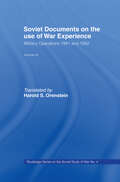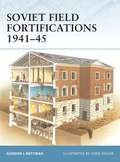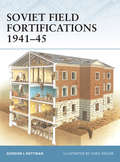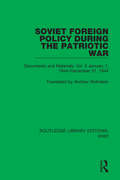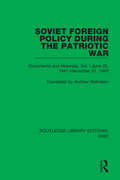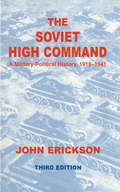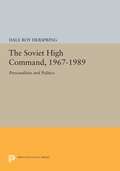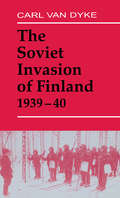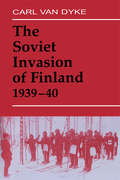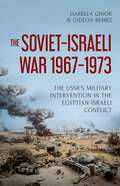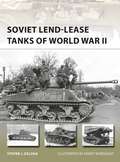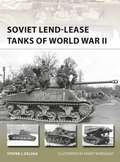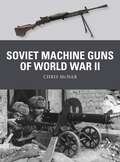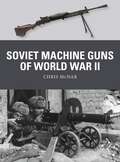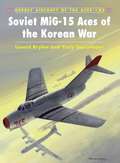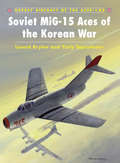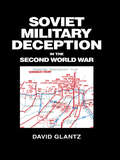- Table View
- List View
Soviet Documents on the Use of War Experience: Volume Three: Military Operations 1941 and 1942 (Soviet (Russian) Study of War)
by Harold S. Orenstein David M. GlantzThe Soviet Study of War" series examines the lessons Soviet military theorists and commanders learned from the study of their own military experience. These are translations of Soviet documents.
Soviet Field Fortifications 1941–45 (Fortress)
by Gordon L. Rottman Chris TaylorFrom June 1941, the Soviets were forced to undertake large-scale defensive operations in the face of the overwhelming German blitzkrieg assault, operations which ran counter to their preference for highly mobile, offensive warfare. Lessons were quickly learned across a wide variety of terrain and climates, including the open steppes, dense forests, wooded swamps, cities, and in snow and ice, where the availability of construction materials differed greatly. The first to cover this topic in the English language and containing detailed information about the trenches, bunkers, observation posts and weapon positions, this book examines field fortifications built from local materials by infantrymen, as well as their use of mines, field camouflage techniques, and construction tools. It provides a first fascinating insight into Russian defensive attempts against the overwhelming might of the German Army.
Soviet Field Fortifications 1941–45 (Fortress #62)
by Gordon L. Rottman Chris TaylorFrom June 1941, the Soviets were forced to undertake large-scale defensive operations in the face of the overwhelming German blitzkrieg assault, operations which ran counter to their preference for highly mobile, offensive warfare. Lessons were quickly learned across a wide variety of terrain and climates, including the open steppes, dense forests, wooded swamps, cities, and in snow and ice, where the availability of construction materials differed greatly. The first to cover this topic in the English language and containing detailed information about the trenches, bunkers, observation posts and weapon positions, this book examines field fortifications built from local materials by infantrymen, as well as their use of mines, field camouflage techniques, and construction tools. It provides a first fascinating insight into Russian defensive attempts against the overwhelming might of the German Army.
Soviet Foreign Policy During the Patriotic War: Documents and Materials. Vol. II January 1, 1944–December 31, 1944 (Routledge Library Editions: WW2 #31)
by Andrew RothsteinThis book, first published in 1946, collects documents illustrating the foreign policy of the Soviet Union during the Second World War. They show how the fighting alliance of the USSR, Britain and the USA came into being and grew stronger, how relations were restored with other anti-Nazi countries, and how diplomatic relations were extended between the USSR and hitherto un-connected countries. The collection of three parts of translated documents: statements and speeches made by Stalin; documents, treaties, agreements; appendices including press statements and telegrams.
Soviet Foreign Policy During the Patriotic War: Documents and Materials. Vol. I June 22, 1941–December 31, 1943 (Routledge Library Editions: WW2 #30)
by Andrew RothsteinThis book, first published in 1946, collects documents illustrating the foreign policy of the Soviet Union during the Second World War. They show how the fighting alliance of the USSR, Britain and the USA came into being and grew stronger, how relations were restored with other anti-Nazi countries, and how diplomatic relations were extended between the USSR and hitherto un-connected countries. The collection of three parts of translated documents: statements and speeches made by Stalin; documents, treaties, agreements; appendices including press statements and telegrams.
Soviet Foreign Policy During the Patriotic War: Documents and Materials. Vol. I June 22, 1941–December 31, 1943 (Routledge Library Editions: WW2 #30)
by Andrew RothsteinThis book, first published in 1946, collects documents illustrating the foreign policy of the Soviet Union during the Second World War. They show how the fighting alliance of the USSR, Britain and the USA came into being and grew stronger, how relations were restored with other anti-Nazi countries, and how diplomatic relations were extended between the USSR and hitherto un-connected countries. The collection of three parts of translated documents: statements and speeches made by Stalin; documents, treaties, agreements; appendices including press statements and telegrams.
Soviet Foreign Policy During the Patriotic War: Documents and Materials. Vol. II January 1, 1944–December 31, 1944 (Routledge Library Editions: WW2 #31)
by Andrew RothsteinThis book, first published in 1946, collects documents illustrating the foreign policy of the Soviet Union during the Second World War. They show how the fighting alliance of the USSR, Britain and the USA came into being and grew stronger, how relations were restored with other anti-Nazi countries, and how diplomatic relations were extended between the USSR and hitherto un-connected countries. The collection of three parts of translated documents: statements and speeches made by Stalin; documents, treaties, agreements; appendices including press statements and telegrams.
The Soviet High Command: A Military Political History, 1918-1941
by John EricksonAn objective and documentary history of the earliest origins and formative years of the Workers-Peasants Red Army from the Civil War to the initial disasters of the war with Germany, the Great Patriotic War, culminating in the "battle for Moscow" in November-December 1941.
The Soviet High Command: A Military Political History, 1918-1941
by John EricksonAn objective and documentary history of the earliest origins and formative years of the Workers-Peasants Red Army from the Civil War to the initial disasters of the war with Germany, the Great Patriotic War, culminating in the "battle for Moscow" in November-December 1941.
The Soviet High Command, 1967-1989: Personalities and Politics
by Dale Roy HerspringThe recent transformations in the USSR are nowhere more evident than in the Soviet military. Top-level military officers have been relieved of their positions, Gorbachev has warned of lean times for the military, the symbolic role of the armed forces has been downgraded, and the concept of "military sufficiency" points to major modifications in Soviet force structure. Contrary to some who see Gorbachev as a Sir Galahad out to slay the evil military high command, Dale Herspring concludes that the relationship between the highest Soviet political and military leaders is at the moment more symbiotic than conflictual. In this first in-depth study of the evolution of civil-military relations in the Soviet Union from 1967 to the present, he shows how the views of senior military officers have varied over time: currently, even if the members of the high command do not like all Gorbachev's changes, they understand the need for them and are prepared to live with them. As Herspring looks at the personalities and politics of eight top military figures, he reveals that the most important of them, Ogarkov, was the first senior Soviet military officer to understand the value of working with the political leadership. Ogarkov believed that the arms control and dtente processes, if carefully managed, could enhance the national security of the USSR. In Gorbachev, the Soviet military has found the type of individual that Ogarkov was seeking.Originally published in 1990.The Princeton Legacy Library uses the latest print-on-demand technology to again make available previously out-of-print books from the distinguished backlist of Princeton University Press. These editions preserve the original texts of these important books while presenting them in durable paperback and hardcover editions. The goal of the Princeton Legacy Library is to vastly increase access to the rich scholarly heritage found in the thousands of books published by Princeton University Press since its founding in 1905.
Soviet Hurricane Aces of World War 2 (Aircraft of the Aces #107)
by Aleksander Rusinov Yuriy RybinFollowing the destruction wrought on the Red Army Air Forces during the first days of Operation Barbarossa in June 1941, the Soviet Union found itself desperately short of fighter aircraft. Premier Josef Stalin duly appealed directly to Prime Minister Winston Churchill for replacement aircraft, and in late 1941 the British delivered the first of 3360 Hurricanes that would be supplied to the Soviet Union under the Lend-Lease agreement. Specifically requested by the USSR, the Hurricanes were quickly thrown into action in early 1942 – the Soviet Air Forces' most difficult year in their opposition to the Luftwaffe. Virtually all the Hurricanes were issued to Soviet fighter regiments in the northern sector of the front, where pilots were initially trained to fly the aircraft by RAF personnel that had accompanied the early Hawker fighters to the USSR. The Hurricane proved to be an easy aircraft to master, even for the poorly trained young Soviet pilots, allowing the Red Army to form a large number of new fighter regiments quickly in the polar area. In spite of a relatively poor top speed, and only a modest rate-of-climb, the Hurricane was the mount of at least 17 Soviet aces.
Soviet Hurricane Aces of World War 2 (Aircraft of the Aces #107)
by Yuriy RybinFollowing the destruction wrought on the Red Army Air Forces during the first days of Operation Barbarossa in June 1941, the Soviet Union found itself desperately short of fighter aircraft. Premier Josef Stalin duly appealed directly to Prime Minister Winston Churchill for replacement aircraft, and in late 1941 the British delivered the first of 3360 Hurricanes that would be supplied to the Soviet Union under the Lend-Lease agreement. Specifically requested by the USSR, the Hurricanes were quickly thrown into action in early 1942 – the Soviet Air Forces' most difficult year in their opposition to the Luftwaffe. Virtually all the Hurricanes were issued to Soviet fighter regiments in the northern sector of the front, where pilots were initially trained to fly the aircraft by RAF personnel that had accompanied the early Hawker fighters to the USSR. The Hurricane proved to be an easy aircraft to master, even for the poorly trained young Soviet pilots, allowing the Red Army to form a large number of new fighter regiments quickly in the polar area. In spite of a relatively poor top speed, and only a modest rate-of-climb, the Hurricane was the mount of at least 17 Soviet aces.
The Soviet Invasion of Finland, 1939-40 (Soviet (Russian) Military Experience #No. 3)
by Carl Van DykeWestern accounts of the Soviet-Finnish war have been reliant on Western sources. Using Russian archival and previously classified secondary sources to document the experience of the Red Army in conflict with Finland, Carl Van Dyke offers a reassessment of the conflict.
The Soviet Invasion of Finland, 1939-40 (Soviet (Russian) Military Experience)
by Carl Van DykeWestern accounts of the Soviet-Finnish war have been reliant on Western sources. Using Russian archival and previously classified secondary sources to document the experience of the Red Army in conflict with Finland, Carl Van Dyke offers a reassessment of the conflict.
The Soviet-Israeli War, 1967-1973: The USSR's Military Intervention in the Egyptian-Israeli Conflict
by Isabella Ginor Gideon RemezRussia's forceful re-entry into the Middle Eastern arena, and the accentuated continuity of Soviet policy and methods of the 1960s and '70s, highlight the topicality of this groundbreaking study, which confirms the USSR's role in shaping Middle Eastern and global history. This book covers the peak of the USSR's direct military involvement in the Egyptian-Israeli conflict. The head-on clash between US-armed Israeli forces and some 20,000 Soviet servicemen with state-of-the-art weaponry turned the Middle East into the hottest front of the Cold War. The Soviets' success in this war of attrition paved the way for their planning and support of Egypt's cross-canal offensive in the 1973 Yom Kippur War. Ginor and Remez challenge a series of long-accepted notions as to the scope, timeline and character of the Soviet intervention and overturn the conventional view that détente with the US induced Moscow to restrainthat a US-Moscow détente led to a curtailment of Egyptian ambitions to recapture of the land it lost to Israel in 1967. Between this analytical rethink and the introduction of an entirely new genre of sources-- -memoirs and other publications by Soviet veterans themselves---The Soviet-Israeli War paves the way for scholars to revisit this pivotal moment in world history.
The Soviet-Israeli War, 1967-1973: The USSR's Military Intervention in the Egyptian-Israeli Conflict
by Isabella Ginor Gideon RemezRussia's forceful re-entry into the Middle Eastern arena, and the accentuated continuity of Soviet policy and methods of the 1960s and '70s, highlight the topicality of this groundbreaking study, which confirms the USSR's role in shaping Middle Eastern and global history. This book covers the peak of the USSR's direct military involvement in the Egyptian-Israeli conflict. The head-on clash between US-armed Israeli forces and some 20,000 Soviet servicemen with state-of-the-art weaponry turned the Middle East into the hottest front of the Cold War. The Soviets' success in this war of attrition paved the way for their planning and support of Egypt's cross-canal offensive in the 1973 Yom Kippur War. Ginor and Remez challenge a series of long-accepted notions as to the scope, timeline and character of the Soviet intervention and overturn the conventional view that détente with the US induced Moscow to restrainthat a US-Moscow détente led to a curtailment of Egyptian ambitions to recapture of the land it lost to Israel in 1967. Between this analytical rethink and the introduction of an entirely new genre of sources-- -memoirs and other publications by Soviet veterans themselves---The Soviet-Israeli War paves the way for scholars to revisit this pivotal moment in world history.
Soviet Lend-Lease Fighter Aces of World War 2 (Aircraft of the Aces)
by Jim Laurier George MellingerBy the end of 1941 the Soviet Union was near collapse and its air force almost annihilated, leaving large numbers of surviving pilots with no aircraft to fly. To help prevent this collapse the UK eventually supplied a total of 4300 Hurricanes and Spitfires to the USSR. After the United States entered the war, the Americans extended Lend-lease to include direct supply to the Soviets as well as the British, and among the aircraft sent were almost 10,000 fighters. Although the aircraft were outdated and often unsuitable to Russian conditions, they served when they were needed, and a number of Russian pilots became Heroes of the Soviet Union flying Lend-lease aircraft. The Soviet government tried to conceal or minimize the importance of Lend-lease fighters well into the 1980s, and the pilots who flew them were discriminated against as 'foreigners'. Only in recent years have these pilots felt free to admit what they flew, and now the fascinating story of these men can emerge.
Soviet Lend-Lease Fighter Aces of World War 2 (Aircraft of the Aces #74)
by Jim Laurier George MellingerBy the end of 1941 the Soviet Union was near collapse and its air force almost annihilated, leaving large numbers of surviving pilots with no aircraft to fly. To help prevent this collapse the UK eventually supplied a total of 4300 Hurricanes and Spitfires to the USSR. After the United States entered the war, the Americans extended Lend-lease to include direct supply to the Soviets as well as the British, and among the aircraft sent were almost 10,000 fighters. Although the aircraft were outdated and often unsuitable to Russian conditions, they served when they were needed, and a number of Russian pilots became Heroes of the Soviet Union flying Lend-lease aircraft. The Soviet government tried to conceal or minimize the importance of Lend-lease fighters well into the 1980s, and the pilots who flew them were discriminated against as 'foreigners'. Only in recent years have these pilots felt free to admit what they flew, and now the fascinating story of these men can emerge.
Soviet Lend-Lease Tanks of World War II (New Vanguard)
by Steven J. Zaloga Henry MorsheadThe Red Army suffered such catastrophic losses of armour in the summer of 1941 that they begged Britain and the United States to send tanks. The first batches arrived in late 1941, just in time to take part in the defence of Moscow. The supplies of British tanks encompassed a very wide range of types including the Matilda, Churchill, and Valentine and even a few Tetrarch airborne tanks. American tanks included the M3 (Stuart) light tank and M3 (Lee) medium tank and the M4 Sherman tank, which became so common in 1944–45 that entire Soviet tank corps were equipped with the type. With these Western tanks, the Soviets were finally able to beat back the German tide in the East.This study examines the different types of tanks shipped to the Soviet Union during the war, Soviet assessments of their merits and problems, and combat accounts of their use in Soviet service using full colour artwork, contemporary photographs and detailed cut-away illustrations.
Soviet Lend-Lease Tanks of World War II (New Vanguard)
by Steven J. Zaloga Henry MorsheadThe Red Army suffered such catastrophic losses of armour in the summer of 1941 that they begged Britain and the United States to send tanks. The first batches arrived in late 1941, just in time to take part in the defence of Moscow. The supplies of British tanks encompassed a very wide range of types including the Matilda, Churchill, and Valentine and even a few Tetrarch airborne tanks. American tanks included the M3 (Stuart) light tank and M3 (Lee) medium tank and the M4 Sherman tank, which became so common in 1944–45 that entire Soviet tank corps were equipped with the type. With these Western tanks, the Soviets were finally able to beat back the German tide in the East.This study examines the different types of tanks shipped to the Soviet Union during the war, Soviet assessments of their merits and problems, and combat accounts of their use in Soviet service using full colour artwork, contemporary photographs and detailed cut-away illustrations.
Soviet Machine Guns of World War II (Weapon #81)
by Chris McNabThis study looks at how the Soviet armed forces developed and deployed a range of machine guns that fitted with their offensive and defensive infantry tactics across six years of total war.In 1939, three machine guns dominated the Red Army's front-line infantry firepower – the DShK 1938 heavy machine gun, the PM M1910 medium/heavy machine gun and the Degtyaryov DP-27, a lighter, bipod-mounted support weapon. Confronted by cutting-edge German technology during the Great Patriotic War (1941–45), the Soviets responded with the development of new weaponry, including the RPD light machine gun, the 7.62×54mmR SG43 medium machine gun and the improved version of the DP-27, the DPM. Taken together, all these weapons gave the Red Army a more practical range of support weapons, better able to challenge the Germans for fire superiority on the battlefield. Fully illustrated, this study explains the technology and the tactics of these machine guns. Noted authority Chris McNab sets out how these machine guns were distributed and tactically applied and provides numerous examples of the weapons in action, from assault teams on the streets of Stalingrad to tank crews struggling for survival at Kursk. The book also reflects upon the weapons' post-war service; many of the machine guns remain in front-line use today. Illustrated with high-quality photographs and specially commissioned artwork, this is a deep analysis of these essential tools of warfare within the Soviet forces.
Soviet Machine Guns of World War II (Weapon #81)
by Chris McNabThis study looks at how the Soviet armed forces developed and deployed a range of machine guns that fitted with their offensive and defensive infantry tactics across six years of total war.In 1939, three machine guns dominated the Red Army's front-line infantry firepower – the DShK 1938 heavy machine gun, the PM M1910 medium/heavy machine gun and the Degtyaryov DP-27, a lighter, bipod-mounted support weapon. Confronted by cutting-edge German technology during the Great Patriotic War (1941–45), the Soviets responded with the development of new weaponry, including the RPD light machine gun, the 7.62×54mmR SG43 medium machine gun and the improved version of the DP-27, the DPM. Taken together, all these weapons gave the Red Army a more practical range of support weapons, better able to challenge the Germans for fire superiority on the battlefield. Fully illustrated, this study explains the technology and the tactics of these machine guns. Noted authority Chris McNab sets out how these machine guns were distributed and tactically applied and provides numerous examples of the weapons in action, from assault teams on the streets of Stalingrad to tank crews struggling for survival at Kursk. The book also reflects upon the weapons' post-war service; many of the machine guns remain in front-line use today. Illustrated with high-quality photographs and specially commissioned artwork, this is a deep analysis of these essential tools of warfare within the Soviet forces.
Soviet MiG-15 Aces of the Korean War (Aircraft of the Aces #82)
by Leonid Krylov Yuriy TepsurkaevThe Soviet Union began assisting the People's Republic of China in its establishment of a modern air force in 1950, when Soviet Air Force regiments were sent to train local pilots. China's involvement in the Korean War in late October 1950 inevitably drew Soviet pilots into the war, with a total of 52 Soviet pilots scoring five or more victories there. The history of these covert actions has been a long-buried secret and this book is the first English publication to detail the only instance when the Cold War became 'hot'. This book uncovers Soviet combat experiences during the Korean War from detailed unit histories and rare first-hand account. With access to extensive Russian archives, the authors offer an enthralling insight into an air war that has been largely covered up and neglected. Illustrated with previously unpublished photographs and detailed full colour profiles, this book is a unique opportunity to read about an often-forgotten aspect of the Cold War.
Soviet MiG-15 Aces of the Korean War (Aircraft of the Aces #82)
by Leonid Krylov Yuriy TepsurkaevThe Soviet Union began assisting the People's Republic of China in its establishment of a modern air force in 1950, when Soviet Air Force regiments were sent to train local pilots. China's involvement in the Korean War in late October 1950 inevitably drew Soviet pilots into the war, with a total of 52 Soviet pilots scoring five or more victories there. The history of these covert actions has been a long-buried secret and this book is the first English publication to detail the only instance when the Cold War became 'hot'. This book uncovers Soviet combat experiences during the Korean War from detailed unit histories and rare first-hand account. With access to extensive Russian archives, the authors offer an enthralling insight into an air war that has been largely covered up and neglected. Illustrated with previously unpublished photographs and detailed full colour profiles, this book is a unique opportunity to read about an often-forgotten aspect of the Cold War.
Soviet Military Deception in the Second World War (Soviet (Russian) Military Theory and Practice)
by David M. GlantzPublished in 1989, Soviet Military Deception in the Second World War is a valuable contribution to the field of Military & Strategic Studies.
